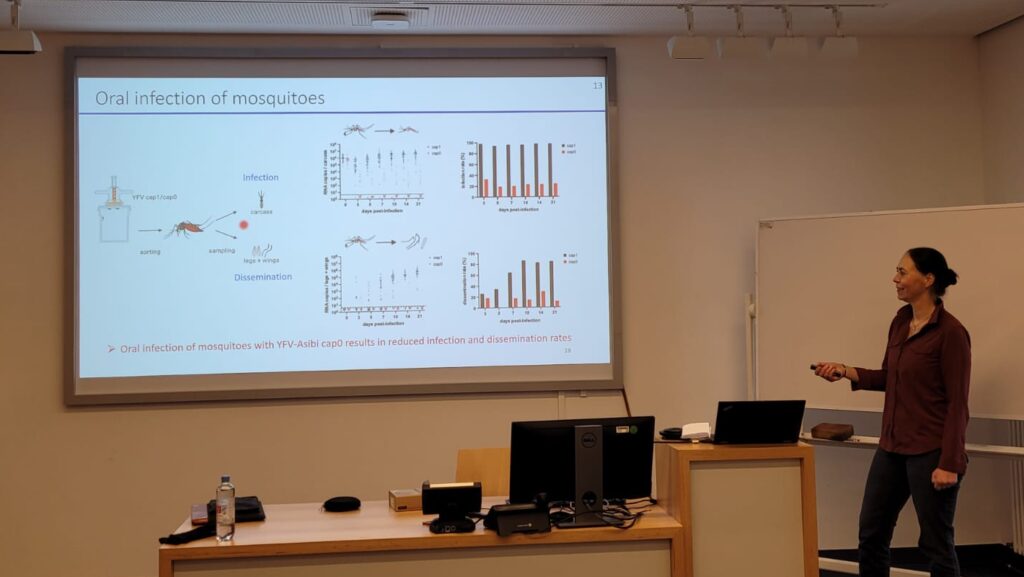Vernetzter Start ins neue Jahr
Von Dr. Nadine Biedenkopf und PD Dr. Beate Kümmerer
Am 15.01.2025 konnte dank Infect-Net PD Dr. Beate Kümmerer vom Institut für Virologie der Uniklinik Bonn ihre Arbeiten zu Orthoflavivirusinfektionen in Moskitos bei Infect-Net-Mitfrau Dr. Nadine Biedenkopf am Institut für Virologie der Philipps-Universität Marburg präsentieren.
Orthoflaviviren kodieren ein Enzym, das ihnen die Bildung einer Cap1-Struktur am 5‘-terminalen Ende des viralen Genoms erlaubt. Für Vertebraten ist bekannt, dass diese Cap1-Struktur im Gegensatz zu einer Cap0-Struktur es dem Virus ermöglicht, sich der Erkennung durch das angeborene Immunsystem zu entziehen und sich somit effizient zu vermehren. Die im Vortrag dargestellten Daten weisen darauf hin, dass auch in Moskitos ein bisher unbekanntes antivirales Protein existiert, das 5‘-terminale RNA-Cap-Modifikationen wie Cap0 in Moskitos erkennt. Die Erkennung der Cap0-Struktur konnte sowohl in Moskitozellen als auch in lebenden Moskitos gezeigt werden. Somit ist die Cap1-Struktur am 5′-Ende des viralen Genoms auch in Mücken wichtig für eine effiziente Replikation und letztendlich für die erfolgreiche Übertragung des Virus durch Moskitos.

Ihre spannenden neuen Erkenntnisse zur Cap0-RNA-Erkennung in Moskitos konnten neben Marburger:innen auch externe Mitfrauen online mitverfolgen.
Nach einer intensiven Diskussion der Daten im Anschluss an den Vortrag war außerdem Zeit für weitere intensive wissenschaftliche Gespräche und Austausch mit weiteren Virolog:innen aus Marburg, u.a. auch mit den Infect-Net-Mitfrauen Prof. Andrea Maisner und Prof. Eva Herker.
Titel des Vortrags: Recognition of 2‘-O-methyltransferase deficient yellow fever virus in mosquitoes
English:
On 15 January 2025, thanks to Infect-Net, PD Dr Beate Kümmerer from the Institute of Virology at Bonn University Hospital was able to present her work on orthoflavivirus infections in mosquitoes to Infect-Net member Dr Nadine Biedenkopf at the Institute of Virology at Philipps University Marburg.
Orthoflaviviruses encode an enzyme that allows them to form a Cap1 structure at the 5′-terminal end of the viral genome. For vertebrates, it is known that this Cap1 structure, in contrast to a Cap0 structure, enables the virus to evade recognition by the innate immune system and thus to replicate efficiently. The data presented in the lecture indicate that a previously unknown antiviral protein also exists in mosquitoes that recognises 5′-terminal RNA cap modifications such as Cap0 in mosquitoes. Recognition of the Cap0 structure was demonstrated both in mosquito cells and in living mosquitoes. Thus, the Cap1 structure at the 5′ end of the viral genome is also important in mosquitoes for efficient replication and ultimately for the successful transmission of the virus by mosquitoes.
Her exciting new findings on Cap0 RNA recognition in mosquitoes could be followed online not only by Marburg residents but also by external colleagues.
After an intensive discussion of the data following the lecture, there was also time for further intensive scientific discussions and exchange with other virologists from Marburg, including Infect-Net colleagues Prof Andrea Maisner and Prof Eva Herker.
Title of the lecture: Recognition of 2′-O-methyltransferase deficient yellow fever virus in mosquitoes
